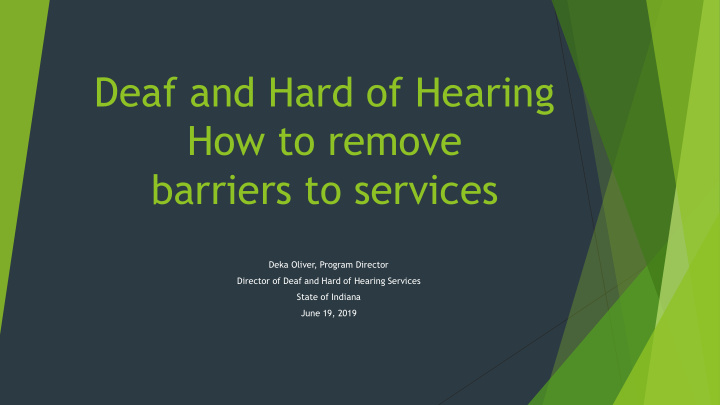



Deaf and Hard of Hearing How to remove barriers to services Deka Oliver, Program Director Director of Deaf and Hard of Hearing Services State of Indiana June 19, 2019
DV Comparing Barriers Hearing Community Deaf Community Large Small Events – Don’t see each other Events - Know/see each other One-on-One relationship Same friends No One-on-One relationship Family support Family cannot communicate Touching community
Cultural Difference Hearing Deaf Pointing is rude Pointing Eye contact is not required Eye contact is NECESSARY Can’t “talk” with mouth full of Can “talk” with mouth full of food food (rude) Tone of voice Body Language including facial expression Short good-bye Over-staying/long good-bye Short introduction Long introduction Use voice to get attention Use shoulder-tapping, waving hands, or tapping on Question – brief and short table Boundary space Question – detailed information DST Direct Boundary space Experience
Myths Speak loud Speak slower All Deaf can lip-read/speak Hearing aids make a person hear Deaf and Dumb
Deaf and Hard of Hearing Communication Modes Manual communication American Sign Language (ASL) Signed Exact English (SEE) Pidgin Sign English (PSE) Rochester Simultaneous Communication (Sim-Comm) Tactile/Tracking Minimum Language Skills (MLS) Oral communication Communication Access Real-Time Transcription Oral Deaf – Lip Readers, Assistive Listening Devices
Accommodation Arrangements Interpreting On-Site Interpreting One-on-One Staff meeting Training/Conference Video Remote Interpreting Computer Access Real-time Transcription (CART) On-Site One-on-One Training Conference Remote
English as a second language 90% of Deaf children are born to hearing parents Delayed Language foundation Average reading level 3.9 Only 25% is understood by lip-reading Examples https://youtu.be/PmHHVaYbNmY Word meanings Run Block Hearing loss https://www.youtube.com/watch?v=it4ZjKQ2WMQ
ASL Word Order English conversation tends S-V-O or S-V order. ASL follows several different “word order” depending on what is needed. ASL does not use BE words (am, is, are, was, were) or anything indicate the state of being and articles (a, an, the), too. T-S-V-O or T-S-V (Time – Subject- Verb- Object) S-V-O Boy Throw Ball T-S-V-O Week past I wash car T-O-V When Car Wash? Humphries T. & Padden, C. – “ Learning ASL”
Video Phone Equipment Sorenson Purple Communication ZVRS High speed internet Web cam Laptop/Device Smart Phone/Tablet
Video Relay Services – phone call, free
Video Remote Interpreting – cost/minute
Deaf VRI experiences Legal Courts Booking Lawyers Hospitals
Communication Access Realtime Translation (CART)
Smart Phones and Tablets Android iPhone Texting Dragon Dictation Email Email Texting Video Phones Video Phones Ntouch (Sorenson) Ntouch (Sorenson) Z5 Mobile (ZVRS) Z5 Mobile (ZVRS) P3 Mobile (Purple VRS) P3 Mobile (Purple VRS) Hamilton Captel Hamilton Captel Clear Caption Clear Captions MiMix3D MiMix3D Pro Deaf Pro Deaf Glide Glide Skype Skype Zoom Zoom AVA AVA
Tips to advocate for survivors when they need interpretation or other services Eye Contact • Talk to the individual • Use nationally certified • Court Certified Interpreters • Qualified interpreters • Interpreters • Each party – defendant and plaintiff • Judge • Certified Deaf Interpreter •
www.dhhs.in.gov Resource Directory
Additional Information Deka Oliver, Program Director Deaf and Hard of Hearing Services 402 West Washington Street, W453 Indianapolis, IN 46204 317-542-3324 deka.oliver@fssa.in.gov
Recommend
More recommend